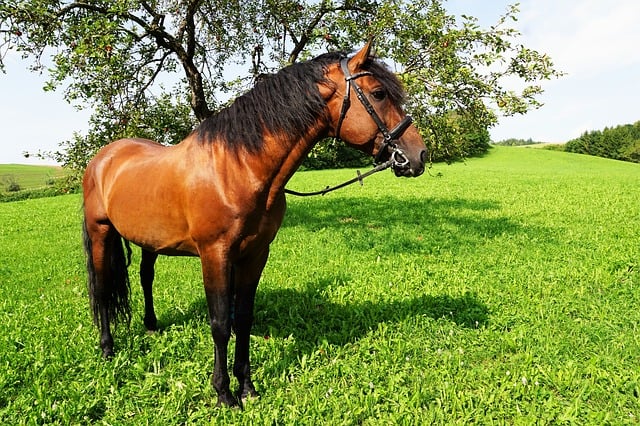
Each year there are often outbreaks of Equine Contagious Diseases, therefore it is important that we keep a watchful eye on our horses for any signs of ill health. Whatever the issue early diagnosis and prompt action combined with attention to detail in the treatment will give the best result in recovery and have the show back on the road.
With an experienced eye on a horse we know well, just a look can be enough to tell you something is amiss. Good observational skills are vital as it is often little clues that all add up together to signal all is not well. However we do have a few measurable signs that we can use to double check that gut feeling
What can we measure?
There are a few things we can actually measure such as temperature, pulse and respiration. These should be fairly consistent in an adult horse at rest and would change if the horse was unwell.
While pulse and respiratory rates tend to drop as a horse gets fitter temperature remains constant. As each horse is an individual it’s vital to establish what is the normal base line temperature for each horse when healthy and not wait until you think it’s ailing before you take it for the first time.
Temperature of the Horse
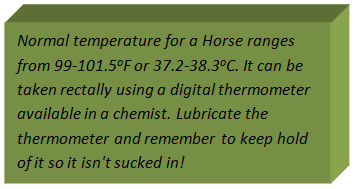
To establish your baseline take temperature at the same time each day for a week and work out the average. If you have an outbreak of infection within your yard or in your area it would be good practice to take temperatures of all horses on a daily basis morning and evening. Some infections cause “biphasic fevers” that show normal temperature in the morning with elevated temperatures in the evening, easily overlooked if only recording in the morning.
*A rise in temperature should always ring the alarm bell, a spike of 40.5C can cause serious complications so don’t wait, call your vet. A dip in temperature can be a sign of shock or precede a viral attack.
*Respiratory infection and infections from cuts generally cause a rise to around 39-40 oC. While viral infections tend to rise to 41-42 oC.*
Respiration of the Horse
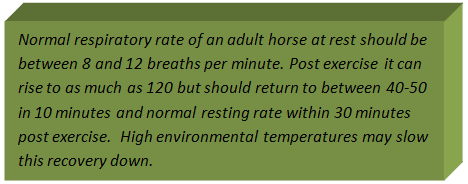
Respiration rate can change with exercise but at rest it should be fairly constant. It can be counted by watching the flanks rise and fall and should be one smooth inhale (the rise) and one smooth movement for the exhale (the fall).
>If your horse is having to use 2 efforts to exhale then he could be suffering from a condition known as COPD (Chronic Obstructive Pulmonary Disease) , directly related to dust and fungal spoors in the environment. Look at the nostrils and check to see if they are flared, this should not happen at rest.
>As well as counting the rate of breaths per minute you should take note of any audible sounds, any wheezing, rasping or rattling should be noted as should a panting breath. Coughing with or without bringing up mucus and any nasal discharge that is a thick mucus.
Call your vet as un-treated respiratory infection can lead to permanent limitations on your horses ability to perform. Many are easily spread to other horses either by direct contact such as touching noses or indirect contact via sharing feed pots for example or bits.
Pulse Rate of a Horse.
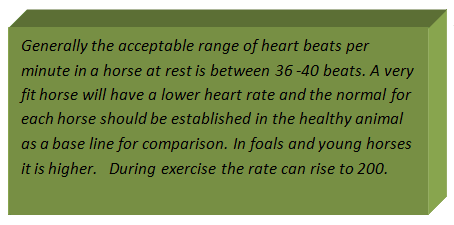
Pulse rate is the same as the rate at which the heart is beating. Exercise, fear, pain, infection, excitement can all alter the heart rate. It is important to ensure that your horse is relaxed when you take this. Even the sight of tack can elevate it.
Heart Rate can be taken using a stethoscope just behind the elbow on the near side and listening to the beat of the horses heart. You will typically hear a characteristic “lub- dub” beat. Each lub dub is one beat.
You can also take the pulse where an artery passes over a bone. This is usually done under the jaw on the external maxillary artery, it takes a bit of practice and remember to use your fingers as you have a pulse in your thumb.
>A heart rate above 80 in non exercising horse or a rate that remains above 60 in a calm resting horse, is cause for concern.
**NB The most common cause of an elevated heart rate is colic pain. The higher the pain level the higher the heart rate.
Other Signs of Health in a Horse.
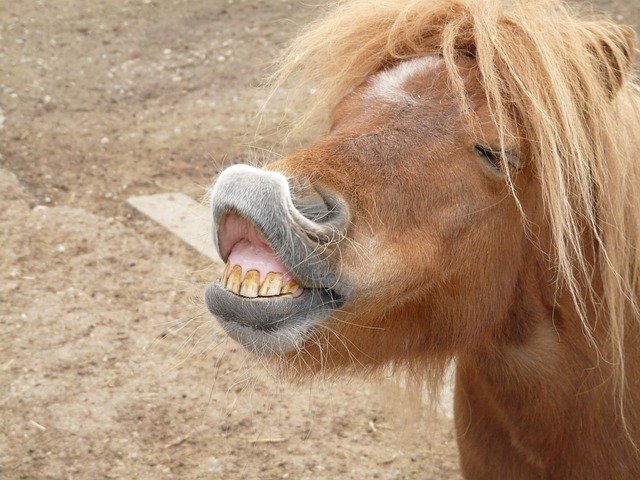
We often identify an ailing person by skin colour such as pale and ashen or red and flushed. A difficult thing to see on the horse due to hair! However we can look at the mucous membranes around the eye and also the colour of the gums in the mouth.
>Very pale gums can indicate anaemia, fever or shock.
>Grey blue colour denotes lack of oxygen in the blood and can be due to shock.
>Yellowish gums can indicate liver problems call your vet.
>If the horse has very red membranes then it could be experiencing some sort of toxaemia or be dehydrated.
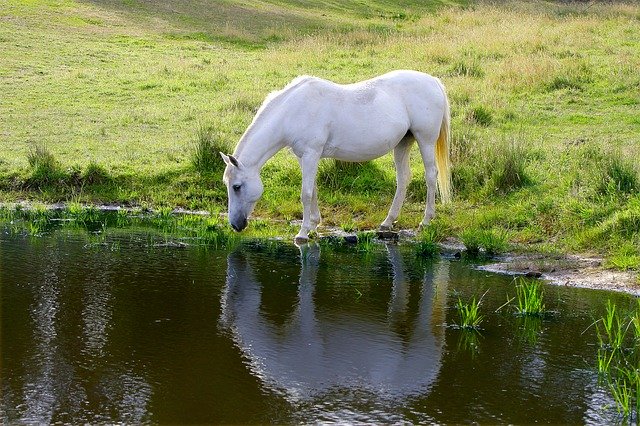
Dehydration has many possible causes and the horses need for water is directly related to diet, air temperature, and exercise and sweat loss. If your horse is on a drinker it is difficult to monitor water consumption.
If you have any concerns about dehydration then it’s possible to do a simple skin pinch test with your fingers on the skin of the neck just in front of the shoulder. If the skin is slow to flatten your horse could be dehydrated.
>Check his gums and water bucket.
Capillary refill time refers to how quick the blood returns to capillaries in the tissue after it has been stopped by applying pressure with your fingers. Lift your horses upper lip and apply pressure to the gum with your thumb, hold for 2 seconds and release.
> If refill takes longer than 2 seconds the horse may have shock.
Although there are things we can measure it is still important to be observant about what is normal for your horse. If there is something “not the norm” and you have no logical, harmless reason then investigate further and take some measurable readings.
Generally with a good environment and proper care and nutrition our horses do very well, but it is important to catch any health issue as early as possible for treatment to be effective.
Jessica Soley BHSI is a level 5 performance coach and Senior assessor for the British Horse Society. Having competed and run her own competition yard she is now an Equine Tutor for QQI Equine courses at level 5&6 run by KWETB in Kildare. This Article was originally published in the February 2019 Issue of Irish Sport Horse Magazine.
All horse images used in this article are from Pixabay.com
